Market
Dubai’s New Ads Rule and More

This week’s roundup highlights regulatory tightening and innovations in the crypto sector across Asia and MENA. Dubai’s regulator implements new crypto marketing rules, which will be effective as of October 1, 2024. Meanwhile, in South Korea, Worldcoin was fined $830,000 for breaching data privacy laws, particularly by collecting sensitive biometric data.
With regulatory authorities stepping up oversight across the region, the crypto industry is experiencing a period of transformation that is reshaping its future.
As of October 1, 2024, companies promoting virtual assets in Dubai must comply with new marketing regulations introduced by the Virtual Asset Regulatory Authority (VARA). Under these guidelines, crypto advertisements must include a prominent disclaimer highlighting the risks of crypto investments. The disclaimer must clearly state that virtual assets can lose value in full or in part and are subject to significant volatility.
In addition to the new disclaimer requirements, VARA has introduced penalties for non-compliance. Firms violating these marketing guidelines could face fines of up to AED 10 million (approximately $2.7 million).
Read more: How Does Regulation Impact Crypto Marketing? A Complete Guide
The size of the fine will depend on the severity of the infraction. If the company repeatedly violates the regulations, it may also face increased fines.
Additionally, virtual asset service providers (VASPs) offering incentives related to virtual assets must now obtain compliance approval from VARA. This ensures that promotional materials do not obscure the risks investors may face when entering the highly volatile crypto market.
This regulatory update is part of Dubai’s ongoing efforts to balance crypto innovation with consumer protection. With the region positioning itself as a global hub for blockchain and digital assets, the new rules aim to safeguard retail and institutional investors from misleading promotional content.
Worldcoin and TFH Hit with $800,000 Fine for Data Breaches in South Korea
South Korea’s Personal Information Protection Commission (PIPC) has fined Worldcoin and its development company, Tools for Humanity (TFH), 1.14 billion Korean won ($830,000). This penalty was for violating the country’s data protection laws.
The fine stems from Worldcoin’s unauthorized collection of sensitive biometric information, including iris scans, from Korean users without proper consent. Moreover, the data was transferred abroad to Germany without notifying users. This action further breaches South Korean data privacy laws.
The PIPC ordered Worldcoin to implement corrective measures, including obtaining explicit user consent for sensitive data collection. The agency also demanded improvements in data storage and use transparency. Furthermore, the firm must introduce an effective data deletion mechanism for users who wish to opt out of the Worldcoin service.
Hong Kong’s Project e-HKD+ Explores Tokenized Assets and Digital Money
Hong Kong’s Monetary Authority (HKMA) recently launched the second phase of its digital currency project, now rebranded as Project e-HKD+. This phase aims to explore more advanced use cases for digital money, including tokenized deposits, as well as broader applications in both retail and corporate settings.
Project e-HKD+ brings together 11 firms that will conduct real-world trials on the settlement of tokenized assets, programmable payments, and offline transactions. These pilot programs are crucial for evaluating the feasibility and benefits of implementing digital currencies within the broader economy.
The outcome of Phase 2 will help shape the future design and regulatory framework for digital currencies in Hong Kong. Authorities will share key learnings with the public by the end of 2025.
Eddie Yue, Chief Executive of the HKMA, emphasized that the initiative is essential for positioning Hong Kong at the forefront of financial technology.
“The e-HKD Pilot Programme has provided a valuable opportunity for the HKMA to explore with the industry how new forms of digital money can add unique value to the general public. The HKMA will continue to adopt a use-case-driven approach in its exploration of digital money. We look forward to working closely with industry participants in Phase 2 to co-create various innovative use cases,” Yue stated.
The authority also plans to establish the e-HKD Industry Forum. This forum will be a collaborative platform where industry leaders can discuss the broader adoption of digital currencies.
Indonesia’s Largest Bank Launches Blockchain-Based Pilot Project
Indonesia’s largest state-owned bank, Bank Rakyat Indonesia (BRI), is launching a blockchain-based pilot project to improve transparency and security in financial transactions. Announced during the Indonesia Blockchain Conference (IBC), the project is designed to streamline supply chains and secure business transactions for BRI’s extensive customer base of 82 million.
Nitia Rahmi, Head of BRI’s Digital Banking Development Department, highlighted that this initiative is part of the bank’s broader commitment to embracing Web3 technologies. Rahmi explained that the project would improve BRI’s digital infrastructure and position the bank as a leader in blockchain adoption within the Indonesian financial sector.
As blockchain technology gains momentum in Southeast Asia, BRI’s move aligns with a growing regional trend of integrating decentralized technologies into traditional banking systems. The bank’s adoption of blockchain is expected to set a precedent for other institutions looking to innovate and improve financial processes.
WazirX Secures Court Moratorium to Restructure After $230 Million Hack
On September 26, Singapore’s High Court granted a four-month moratorium to Zettai Pte Ltd, the parent company of the Indian crypto exchange WazirX. This decision follows the platform’s $230 million exploit in July.
This moratorium allows WazirX to restructure its liabilities and address users’ outstanding cryptocurrency balances. Initially, the exchange requested a six-month moratorium. However, the court decided on a four-month moratorium, factoring in the automatic 30-day moratorium that started with the initial filing.
Nischal Shetty, Director of Zettai and Founder of WazirX, expressed gratitude for the court’s decision. He described it as a critical step toward recovery and resolution. Shetty also emphasized that this breathing space is necessary for developing a fair, creditor-approved restructuring plan that maximizes recovery potential for affected users.
As part of the court’s conditions, WazirX has committed to full transparency. The exchange will make its wallet addresses public, release financial data, and address user concerns raised during the legal proceedings. Additionally, future voting on restructuring plans will be supervised by independent parties to ensure impartiality.
Read more: Crypto Project Security: A Guide to Early Threat Detection
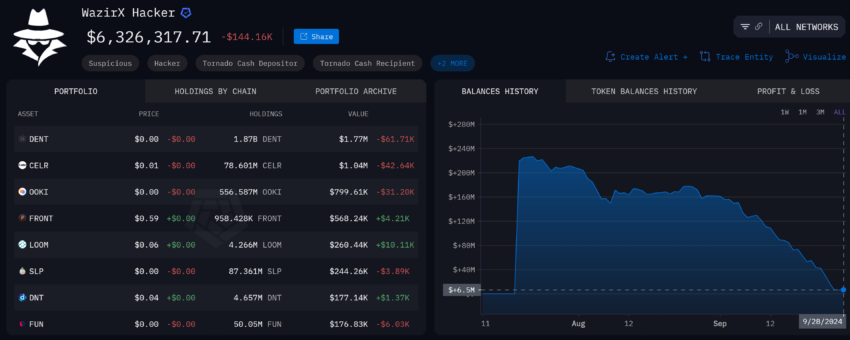
In parallel with these legal proceedings, blockchain data from Arkham Intelligence revealed that the hacker responsible for the exploit has almost entirely laundered the stolen assets. Of the $230 million, only $6 million of cryptocurrencies remains unlaundered. The hacker funneled the majority of the funds through the crypto mixer Tornado Cash.
Disclaimer
In adherence to the Trust Project guidelines, BeInCrypto is committed to unbiased, transparent reporting. This news article aims to provide accurate, timely information. However, readers are advised to verify facts independently and consult with a professional before making any decisions based on this content. Please note that our Terms and Conditions, Privacy Policy, and Disclaimers have been updated.
Market
Report Alleges Massive Meme Coin Sniping on Pump.fun

According to a new report from Pine Analytics, token deployers on Pump.fun systematically funded sniper wallets to buy their own meme coins. This impacted over 15,000 token launches on the platform.
These sniper wallets operated primarily during US trading hours, executing standardized, profitable strategies. Unrelated bot activity obscures their behavior, making it extremely difficult to isolate these wallets—and they can readily adapt to new countermeasures.
Snipers Roam Free on Pump.fun Meme Coins
Pump.fun has remained one of the most popular meme coin launchpads on Solana despite persistent controversies and other criticism.
However, Pine Analytics’ new report has uncovered a new controversy, discovering systematic market manipulation on the platform. These snipes include as much as 1.75% of all launch activity on Pump.fun.
“Our analysis reveals that this tactic is not rare or fringe — over the past month alone, more than 15,000 SOL in realized profit was extracted through this method, across 15,000+ launches involving 4,600+ sniper wallets and 10,400+ deployers. These wallets demonstrate unusually high success rates (87% of snipes were profitable), clean exits, and structured operational patterns,” it claimed.
Solana meme coin deployers on Pump.fun follow a consistent pattern. They fund one or more sniper wallets and grant them advance notice of upcoming token launches.
Those wallets purchase tokens in the very first block and then liquidate almost immediately—85% within five minutes and 90% in just one or two swap events.

Pump.fun meme coin developers exploit this tactic to create the appearance of immediate demand for their tokens. Retail investors, unaware of the prior sell‑off, often purchase these tokens after the snipe, giving developers an unfair advantage. This constitutes market manipulation and erodes trust in the platform.
Pine Analytics had to carefully calibrate its methods to identify genuine snipers. Apparently, 50% of meme coin launches on Pump.fun involve sniping, but most of this is probably bots using the “spray and pray” method.
However, by filtering out snipers with no direct links to developer wallets, the firm missed projects that covered their tracks through proxies and burners.
In other words, the meme coin community does not have adequate defenses against systematic abuse on Pump.fun. There are a few possible ways that the platform could flag repeat offenders and sketchy projects, but adaptive countermeasures could defeat them. This problem demands persistent and proactive action.
Unfortunately, it may be difficult to enact such policies. Meme coin sniping is so systematic that Pump.fun could only fight it with real commitment.
Analysts think that building an on-chain culture that rewards transparency over extraction is the best long-term solution. A shift like that would be truly seismic, and the meme coin sector might not survive it.
Disclaimer
In adherence to the Trust Project guidelines, BeInCrypto is committed to unbiased, transparent reporting. This news article aims to provide accurate, timely information. However, readers are advised to verify facts independently and consult with a professional before making any decisions based on this content. Please note that our Terms and Conditions, Privacy Policy, and Disclaimers have been updated.
Market
Solana Leads Blockchain Metrics as SOL Momentum Builds
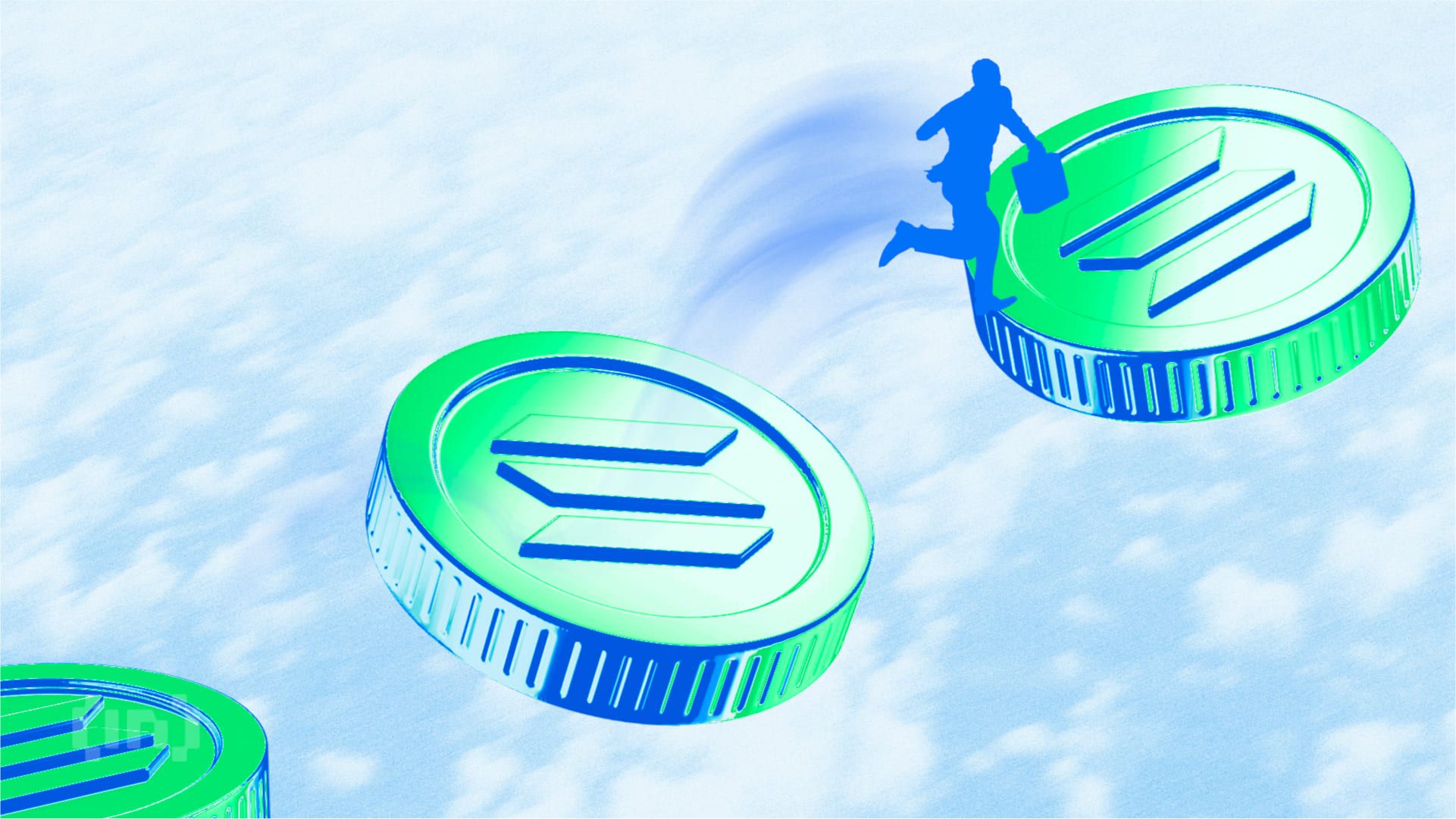
Solana (SOL) continues to show strength across multiple fronts, maintaining a bullish structure on its Ichimoku Cloud chart while gaining momentum in key market metrics. The BBTrend indicator has turned higher again, signaling renewed buying pressure after a brief cooldown.
On-chain activity remains strong, with Solana leading all blockchains in DEX volume and dominating fee generation thanks to the explosive growth of meme coins and launchpad activity. With SOL now trading above a key resistance level, the path is open for further upside—though a loss of momentum could still trigger a retest of lower supports.
Solana Maintains Bullish Structure, but Momentum Faces Key Test
On Solana’s Ichimoku Cloud chart, the price is currently above the Kijun-sen (red base line) but has dipped below the Tenkan-sen (blue conversion line), signaling weakening short-term momentum.
The flattening Tenkan-sen and price behavior suggest possible consolidation or the early stages of a pullback. Still, with the price holding above the Kijun-sen, medium-term support remains intact.
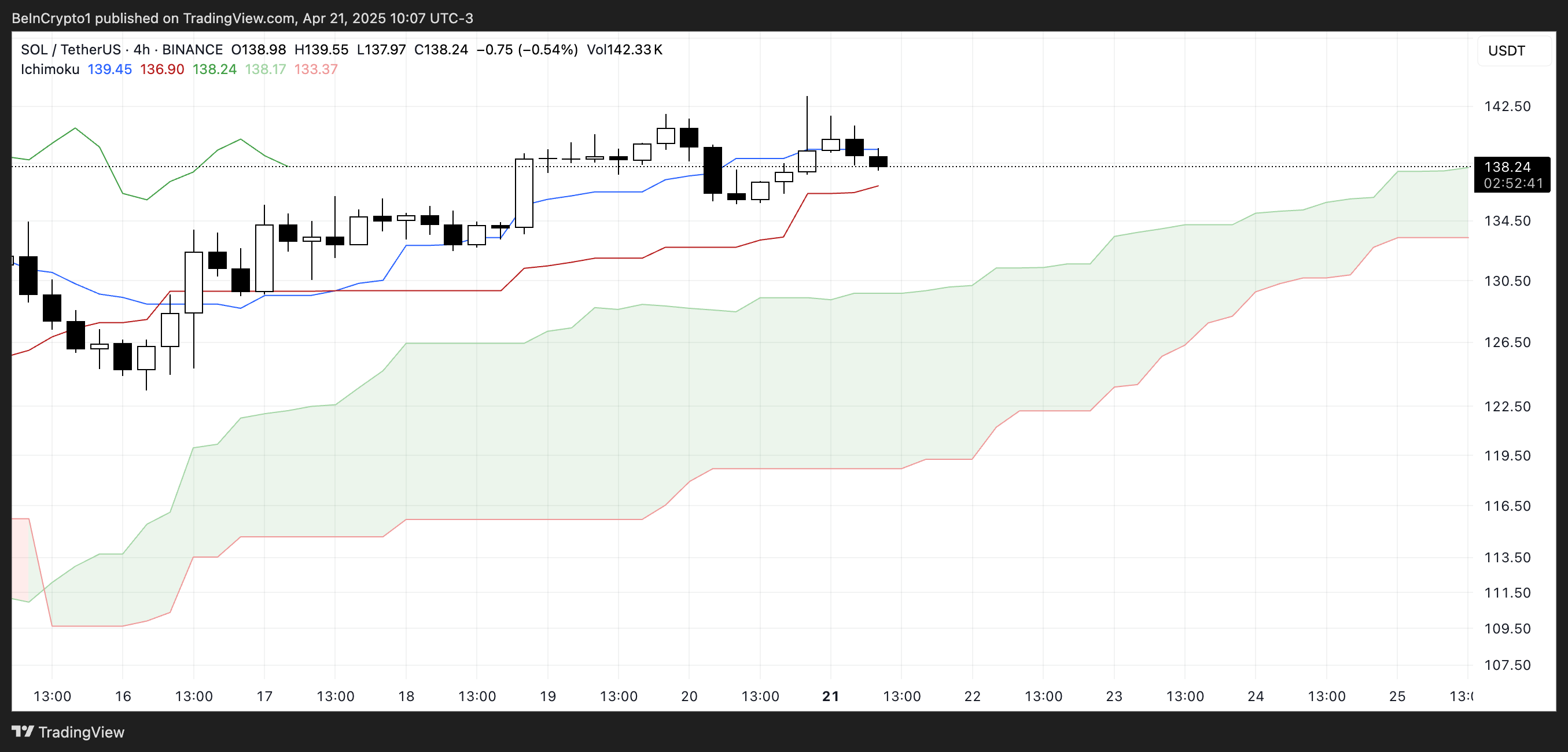
The overall Ichimoku structure remains bullish, with a thick, rising cloud and leading span A well above span B—indicating strong underlying support.
If Solana finds support at the Kijun-sen and climbs back above the Tenkan-sen, the uptrend could regain strength; otherwise, a test of the cloud’s upper boundary may follow.

Meanwhile, Solana’s BBTrend is currently at 6, extending nearly ten days in positive territory after peaking at 17.5 on April 14. The recent increase from 4.26 to 6 suggests renewed bullish momentum following a brief cooldown.
BBTrend, or Bollinger Band Trend, tracks the strength of price movement based on Bollinger Band expansion.
Positive values like the current one point to an active uptrend, and if the BBTrend continues to rise, it could signal stronger momentum and potential for another upward move.
Solana Dominates DEX Volume and Fee Generation as Meme Coins Drive Ecosystem Growth
Solana has once again claimed the top spot among all chains in DEX volume, recording $15.15 billion over the past seven days. The combined total of Ethereum, BNB, Base, and Arbitrum reached $22.7 billion.

In the last 24 hours alone, Solana saw $1.67 billion in volume, largely fueled by its booming meme coin ecosystem and the ongoing launchpad battle between PumpFun and Raydium. Adding to this good momentum, Solana recently surpassed Ethereum in Staking Market Cap.

When it comes to application fees, Solana’s momentum is just as clear. Four of the top ten fee-generating apps over the past week—PumpFun, Jupiter, Jito, and Meteora—are Solana-focused.
Pump leads the pack with nearly $18 million in fees alone.
Solana Breaks Key Resistance as Uptrend Targets Higher Levels, but Risks Remain
Solana has finally broken above its key resistance at $136, flipping it into a new support level that was successfully tested just yesterday.
Its EMA lines remain aligned in a bullish setup, suggesting the uptrend is still intact.
If this momentum continues, SOL price could aim for the next resistance zones at $147 and $152—levels that, if breached, open the door to a potential move toward $179.
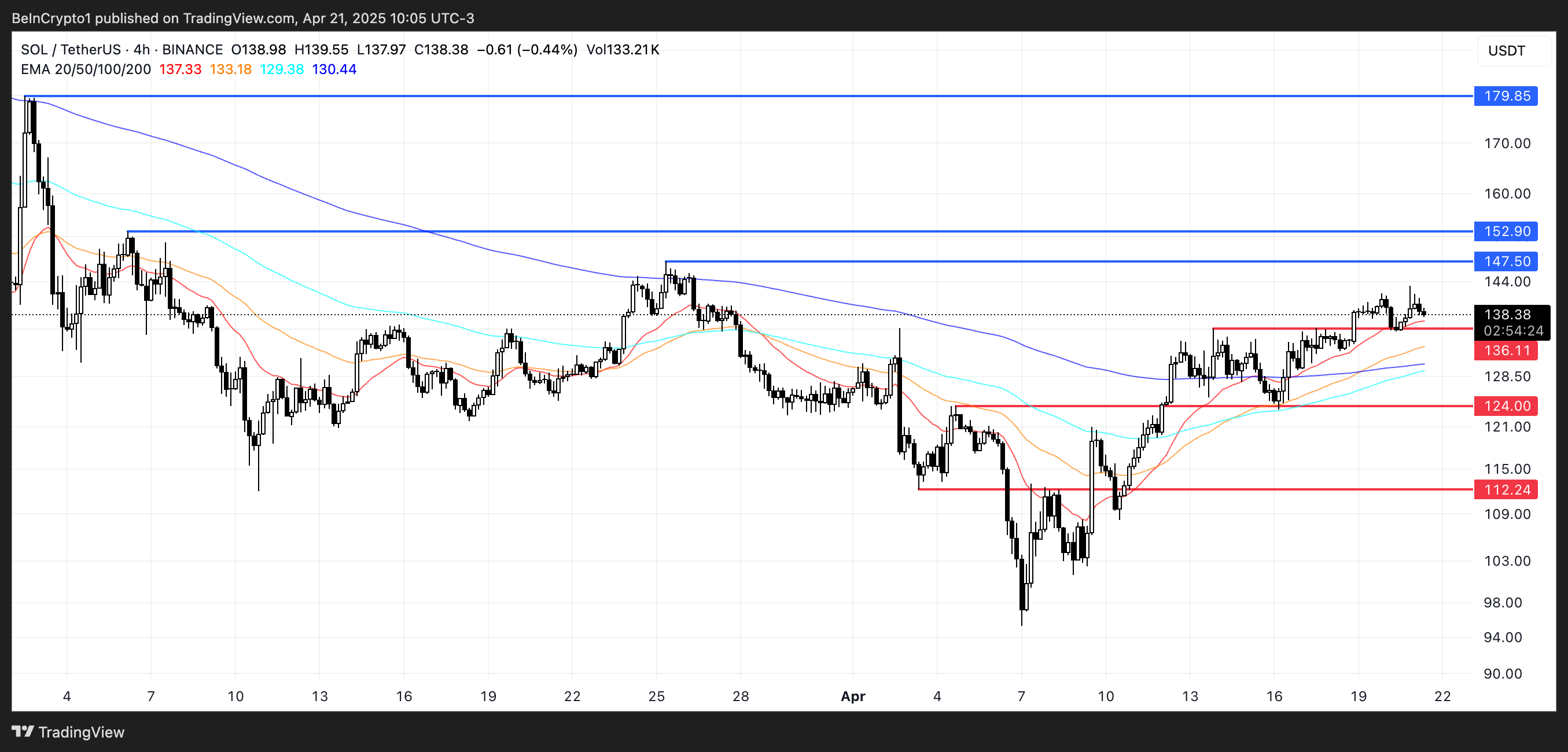
The current structure favors buyers, with higher lows and strong support reinforcing the trend.
However, if momentum fades, a retest of the $136 support is likely.
A breakdown below that level could shift sentiment, exposing Solana to deeper pullbacks toward $124 and even $112.
Disclaimer
In line with the Trust Project guidelines, this price analysis article is for informational purposes only and should not be considered financial or investment advice. BeInCrypto is committed to accurate, unbiased reporting, but market conditions are subject to change without notice. Always conduct your own research and consult with a professional before making any financial decisions. Please note that our Terms and Conditions, Privacy Policy, and Disclaimers have been updated.
Market
Crypto Firms Donated $85 million in Trump’s Inauguration
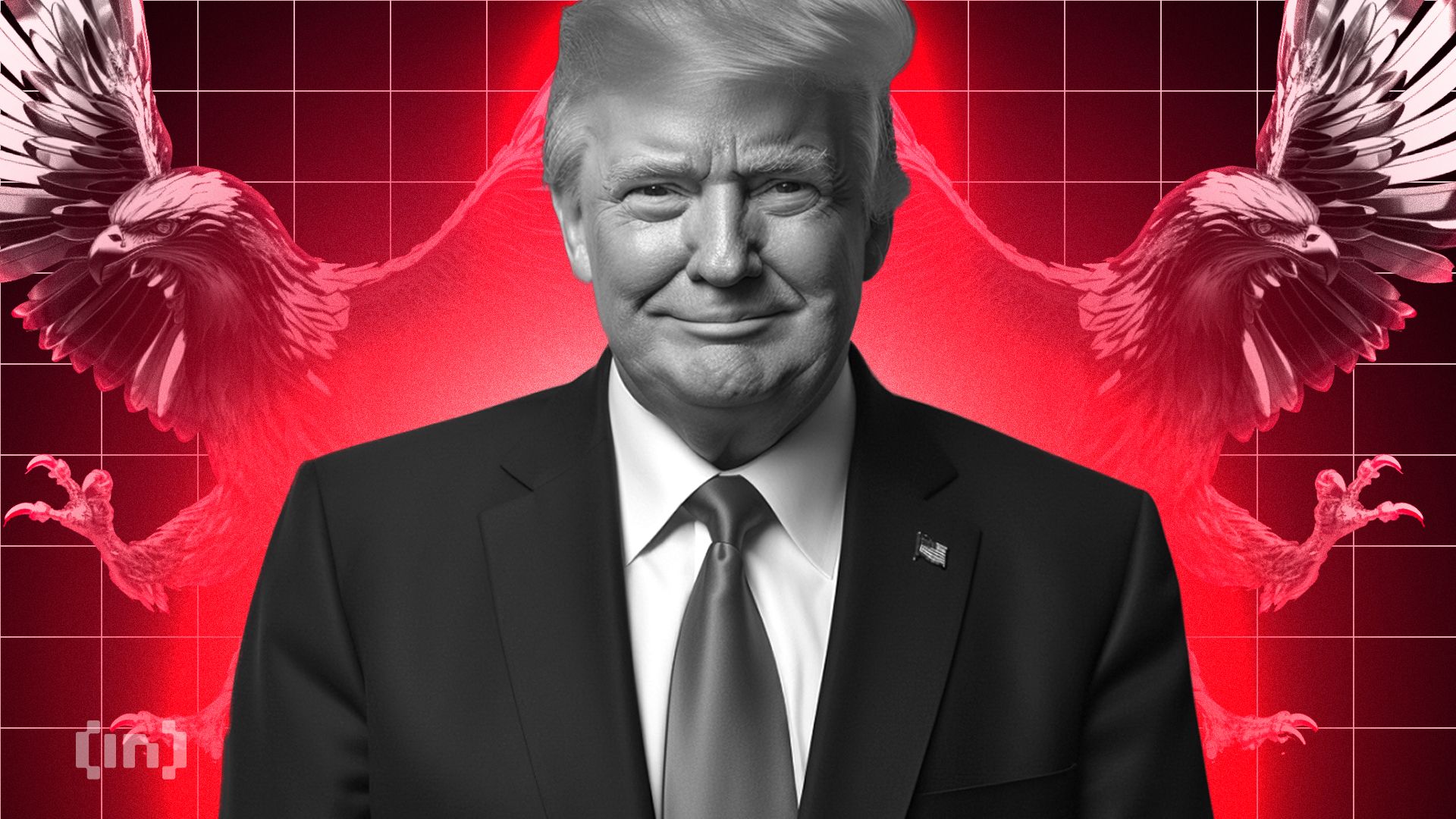
According to a new report, 15 firms and individuals from the crypto industry donated more than $100,000 to President Trump’s Inauguration, totaling over $85 million.
Almost all of these companies apparently received direct or indirect benefits from Trump’s administration. This includes dropped legal proceedings, lucrative business partnerships, participation in Trump’s Crypto Summit, and more.
Crypto Industry Went All-In on Trump’s Inauguration
Since promising to bring friendlier regulations on the campaign trail, Donald Trump attracted a reputation as the Crypto President.
Trump’s Inauguration festivities included a “Crypto Ball,” and several prominent firms made donations for these events. Today, a report has compiled all crypto-related contributions of over $100,000, revealing some interesting facts.

Since taking office, President Trump and his family have been allegedly involved in prominent crypto controversies, and these donations may be linked to several of them.
For example, eight of the donors, Coinbase, Crypto.com, Uniswap, Yuga Labs, Kraken, Ripple, Robinhood, and Consensys, had SEC investigations or lawsuits against them closed since Trump’s term began.
The commission might have dropped its probe against these companies anyway due to its changing stance on crypto enforcement. However, being in the President’s good books likely helped the process.
Further Alleged Benefits for Donors
In other words, nearly half the firms that made donations to Trump’s Inauguration have seen their legal problems cleared up quickly. This isn’t the only regulation-related benefit they allegedly received.
Circle, for example, recently made an IPO after openly stating that Trump’s Presidency made it possible. Galaxy Digital received SEC approval for a major reorganization, a key step for a NASDAQ listing.
Other donors, such as Crypto.com and ONDO, got more direct financial partnerships with businesses associated with the Trump family.
Previously, Ripple’s CEO, Brad Garlinghouse, anticipated a crypto bull market under Trump. Also, XRP, Solana, and Cardano were all unexpectedly included in the US Crypto Reserve announcement.
All three of these companies made major donations to Trump’s Inauguration.
It seems that most of the firms involved got at least some sort of noticeable benefit from these donations. Donors like Multicoin and Paradigm received invitations to Trump’s Crypto Summit, while much more prominent groups like the Ethereum Foundation got snubbed.
Meanwhile, various industry KOLs and community members have already alleged major corruption in Trump’s crypto connections.
While some allegations might lack substantial proof, the crypto space has changed dramatically under the new administration, for both good and bad.
Disclaimer
In adherence to the Trust Project guidelines, BeInCrypto is committed to unbiased, transparent reporting. This news article aims to provide accurate, timely information. However, readers are advised to verify facts independently and consult with a professional before making any decisions based on this content. Please note that our Terms and Conditions, Privacy Policy, and Disclaimers have been updated.





















